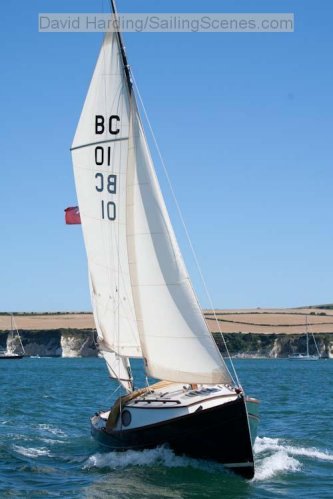I have to get my boat off her mooring in Poole Harbour by the end of the month, so not many sailing days left. I'm not a winter sailor. I like a break from any activity and the anticipation of the next season.
As I will be getting her onto her trailer on my own, I thought I had better practice getting the mast down as I have never lowered it myself. So I sailed to Brownsea Island and beached her at about half tide on the ebb. When she was firmly aground she dried out pretty level, with just a little rocking from side to side as I moved around. Then to lower the mast for the first time.
I had asked Matt Newland to rig her with a forestay and a separate furling jib, set inside of the stay. The idea was that I could lower the sail at any time, without having to lower the mast. This means the forestay has to be released first, and then as the jib halyard is loosened, the mast tips backwards. It worked fine, but the mast could swing from side to side in a wind until you can grab it as it comes down. As it is carbon fibre it is "light" but only compared to a wooden one. It is still quite a weight. Once it was down I decided that I would change the forestay arrangement. I have never lowered the jib in practice, so I removed the seperate forestay and moved the jib tack out to the stem head and the jib head up to the slightly higher forestay fitting on the mast (no photos, I fogot my camera). Then the raising...
It would be very straight forward if you had three arms. I don't. You push up the mast with one hand and use the other two to take in the slack on the jib halyard. In practice I found that you can push the mast right up until it is vertical and the shrouds tighten and brace it. Then you pull in the halyard using your spare hand and your teeth. Not sure what the chief medical officer would say about that. The real trick is getting from the cockpit, where you have to stand to start pushing the mast up, to the cabin roof, where you have to be to push the mast vertical in the tabernacle. I can't really remember how I did it. I think I built a stairway of flat fenders to climb on. You couldn't do it solo afloat or in a strong side wind. Anyway it went up without mishap. I wouldn't try to raise it just hauling on the halyard. The sideways leverage on the tabernacle would be huge if the mast started to sway before the shrouds tightened.
Moving the jib to the stem head is a revelation. I am sure that is where it was meant to be. (I think Matt said as much once). The sail sets much flatter, there is less weather helm and you can actually see under it. Before, everything off the leeward bow was a mystery, but now I can see it. She also self steers even more consistently, to the extent that I can leave the helm to go below to fetch things without disaster striking. I spent quite a lot of time sailing along with one hand behind my head and the other holding a drink. A bit like cycling with no hands. I felt like waving at passing boats with both hands, but that seemd to be asking for trouble.
Saturday was one of those beautiful September days we sometimes get. I sailed to Studland and anchored close to shore. Rowed in and went up to the pub (the Banks Arms, a lovely ancient pub overlooking Poole Bay) for coffee. Then I sailed to the beach and learned a lesson.
I rowed ashore in my inflatable tender and there were some very small waves just breaking on the sand. I lined up my transom to one so it would wash me in for the last 5m. It picked me up, spun the boat sideways and dumped me completely underwater and under the boat in less than a second. Five seconds later I was standing on dry land thinking "I'm all wet, that wasn't in the plan". Never under estimate the power of a wave.
Very gentle winds so I sailed slowly back to my mooring, only using the engine for the last mile because the ebb tide was pushing me backwards. Many boast are off their moorings already, so it is very quiet in the channel now.
Subscribe to:
Post Comments (Atom)

No comments:
Post a Comment